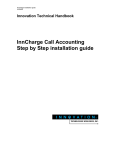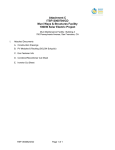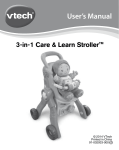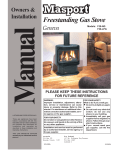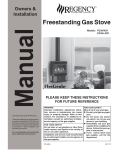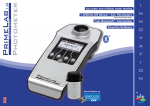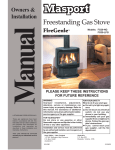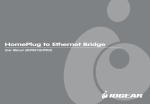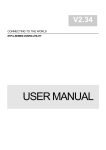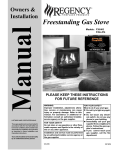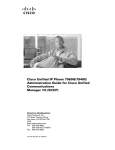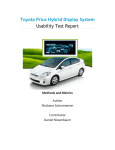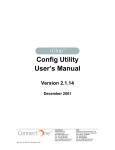Download C Vu Volume 1 Issue 2 PDF
Transcript
Volume 1
C Vu
Issue 2
The Magazine of the C Users' Group (U.K.)
Editorial
Welcome to the second issue of "C Vu", the magazine of the C Users' Group (UK). Since the last
issue membership of the group has been going up in leaps and bounds, mainly as a result of a large
plug in the user group section of Personal Computer World this month. By whatever route you
came to join CUG(UK) you are very welcome!
As you are probably aware, CUG(UK) has two main aims - supporting the C language itself, and
also other areas which relate to it. One of these "other areas" is, of course, operating systems. As if
to prove the point, we take an in-depth look at the Mirage OS in this issue, and future issues will
cover OS-9, Minix and distributed operating systems.
As with any publication, "C Vu" relies heavily on its readers for articles, reviews, etc. Many of you
may be fairly new to C and going prematurely grey trying to get the hang of some of C's more
idiosyncratic features. Don't just sit there, write to us with your problem and we will try to help. If
enough people are interested, we will start a series on C for beginners, or perhaps the occasional
article on certain areas (pointers being the obvious example!) This applies to any articles in "C Vu"
as well, if you don't understand anything, write in and we'll attempt to explain it.
SPECIAL OFFER!
It's special offer time again! Last issue we brought you the MIX C system at under half price, this
time we bring you the rather natty Discovery 1200P Pocket Modem, for under 110 pounds. Full
details inside.
CUG(UK) is still in the early stages of development, so you may notice that things seem to change
from one issue of "C Vu" to the next. The astute amongst you will have noticed the page
numbering went a little awry in our first issue. So, to make sure this doesn't happen again, I've
dispensed with page numbers altogether!
People have a wide variety of printers, font sizes, favourite paper sizes, etc. so future issues of "C
Vu" (on disk or bulletin boards) will be in PROFF format (or something similar). When I have
decided upon this, the necessary programs will appear in the CUG(UK) library, although as PROFF
format is pure ASCII it is not essential to have the programs to be able to print out "C Vu".
THE NEXT ISSUE
Please get your letters, articles, and reviews to me AS SOON AS POSSIBLE. Preferably on disk, in
straight ASCII (no margins please!). Mail can be sent via Martin Houston (address on the back
page). If everything goes okay, the next issue of "C Vu" can be expected in late March.
Phil J Stubbington
Editor
-1-
Volume 1
C Vu
CONTENTS
REGULARS:
o Editorial
A few words from the editor
o Letters Page
Commenting programs, how and why
o Everything You Wanted To Know About C .....
Tips and Tricks from Steven Palmer
o The Back Page
How to receive "C Vu" on disk, and a
membership form to get your friends interested!
SPECIAL OFFER:
o The Discovery 1200P pocket modem... 300/300 and
1200/1200 baud communications for under 110 pounds.
Brought to you by Digital Matrix Ltd.
SERIES:
o Structure, Part 2
*** Due to lack of space, this has been ***
*** held over until the next issue ***
Colin Masterson
ARTICLES:
o Get Online With Our Modem Offer
How to keep in touch by modem
Martin Houston
o The C Source Library
o A Wander Through The C Source Library
How the library is organised, what it will
cost you, and what's in it
Martin Houston
o Minix
How to get in touch with our Minix coordinator
REVIEWS:
o Mirage
A versatile operating system for Motorola systems
Phil J Stubbington
o C Programmers Guide To Serial Communications
From ASCII to XMODEM, via KERMIT!
Martin Houston
JOB OFFERS:
o News from Apricot
-2-
Issue 2
Volume 1
C Vu
Issue 2
GET ONLINE WITH OUR MODEM OFFER
By Martin Houston
The CUG is now active on a number of Bulletin Board services (listed below). If you do not have a
modem then you are missing out on the ability to download items from the library (for no charge!)
and send in your comments in a form that can easily get into the magazine. We have negotiated a
special offer on a modem that should suit the needs of many CUG members at a very keen price!
It's pocket sized, comes in its own carrying wallet, and should work with any micro equipped with
an RS232 port, it's.......
●
●
●
●
●
●
●
●
THE DISCOVERY 1200P POCKET MODEM!
HAYES COMPATIBLE - AUTO DIAL - AUTO ANSWER!
300/300 AND 1200/1200, CCITT AND BELL COMPATIBLE!
RUNS OFF A PP3 CALCULATOR BATTERY!
SUB-MINIATURE CALL MONITORING LOUDSPEAKER!
JUST 109.25 POUNDS TO CUG MEMBERS (5 POUNDS OFF)
PRICE INCLUDES VAT AND CARRIAGE
ONLY AVAILABLE FROM:
DIGITAL MATRIX LTD.
75 Willow Road,
Solihull,
West Midlands,
B91 1UF
Tel.: 021 704 1399.
This modem supports the more sensible V22 standard instead of the silly & antiquated V23 that
many budget priced modems support. V23 is all very well if all you are doing is downloading large
quantities of information but having to upload at a snails pace 75 baud means that V23 is a poor
choice for anyone serious about a 2 way flow of information. A V22 modem will give a full 1200
baud speed in BOTH directions. The 300 baud V21 standard is provided for calling older, slower
modems. West Midlands Opus & Dr Solomons Fido already support V22 operation and Chronos
Lair is due to go V22 very shortly (and may have done so by the time you read this).
The cost of putting your machine 'online' is not as great as you might expect. Under 110 pounds for
a Discovery 1200P, another few pounds for some communication software of your choice and the
phone bill. What many people dread when they think about a modem is the huge increase in the
phone bill! If you are sensible about modem use this is not as big a problem as expected.
The secret of economical modem use is to stick to off peak times. Calling a BBS in your own local
call area is 5 pence for 5 minutes at cheap rate. This works out at only 60p an hour for a useful &
entertaining passtime. the BBS is long distance over a 'low cost' route - such as calling a
Birmingham number from London the charge is only 25p for 5 minutes or 3 pounds an hour.
Normal long distance routes will cost 35p for 5 minutes or 4.20 an hour. Modem communications
is an exciting and absorbing hobby & well worth getting into.
-3-
C Vu
Volume 1
Issue 2
Digital Matrix also does an extensive range of other modems at higher prices - contact Clive
Warner at Digital Matrix for more details.
LIST OF BBS KNOWN TO CUG
●
●
●
●
●
●
Chronosoft Lair
021 744 5561
300N81 V21/23 at present
Digital Matrix
021 705 5187
1200N81 V21/22
West Midlands Opus
021 711 1451
1200N81 All speeds
Dr Solomon's FIDO
024 03 4946
1200N81 All speeds
Academics
021 705 9677
300N81 V21/23
CIX
01 399 5252
All speeds
You will find a warm welcome from the sysop on all of these boards if you say you a CUG
member. If anyone knows of any other BBS that have an interest in C I would like to know about
them so that this list can be updated for the next edition of C Vu.
West Midlands Opus is well worth a call as it is participating in the international C programmers
conference on ECHOMAIL. There is much interesting material in the conference, most of it is of
U.S. origin. The board runs V21 through to V22bis with MNP error correction as well so if you
have a high speed modem then downloading from this board can be very economical.
Dr Solomons FIDO is a very popular system & can be hard to get onto at times but always contains
interesting technical material.
The best way to get into contact with me is to leave a message on one of these boards & I will reply.
Any articles uploaded onto one of these boards can easily find its way into the next issue of C Vu.
Keeping things computer readable makes life easier for everyone!
Letters Page
A letter has flooded in from Colin Masterson, the author of our series on structured programming:-
-4-
Volume 1
C Vu
Issue 2
I hope that readers might bear with me as I once more bang the drum about one of my 'hot topics' that of commenting programs; let's be specific, commenting C programs.
As Mark Burgess seemed to be suggesting in a recent article in PCW, perhaps the time has come to
try to standardise in some way a level of commenting which, together with structuring, will improve
the useability, if I may use that word, of our software. As I see it, when we write a function - no
matter how small - we have three clear obligations.
These may be summarised as follows:
1. Primary Obligation. To other users (& the author)
a) To provide sufficient information to allow anyone to call the function correctly and to make
sense of any returned value.
b) To inform the user WHAT action is performed.
2. Secondary Obligation. To author (& further details for user)
a) To present a structural summary.
b) To note any peculiarities about the method employed such as recursion, calls to BIOS, DOS or
I/O which may lead to portability restrictions.
3. Tertiary Obligation. (If function complex or part of suite)
a) Indicate caller function and/or related functions.
b) Indicate function level in the program hierarchy.
c) Indicate version, amendments and revision history.
d) Indicate any test or QA programs.
I shall propose a function header shortly which consists three parts corresponding to these three
obligations, each part comprising a number of 'fields'.
Not all parts will be relevant in every case. The style and layout of the header may be left to the
individual but some points may be worth noting. Consideration should be given to a standard form
which would enable the use of utilities and filters to perform certain documentation and indexing
tasks automatically. (eg through the use of GREP and the like.)
Since most people make use of a text editor with block copy and insert facilities, it makes sense to
have a single dummy header and insert this into the source as required.
Furthermore, the NAME and CALL METHOD fields may often be directly copied from the
function definition, avoiding repeated typing. (ED - an example of the header is given later on).
The need for information as noted under obligation 1 must surely be clear to everyone. For
-5-
C Vu
Volume 1
Issue 2
complex functions the explanation of functions and parameters may be quite lengthy. For simple
functions, very brief. The need for the following parts may be less obvious. In general though, it
ought to be possible to fully understand the implications of using a function without having to study
the code itself. Recursive functions or ones with a large quantity of local variables, place a heavy
demand on the stack. This is worth noting.
If calls are made to routines such as interrupts, this has an effect on portability and should also be
noted. For more detailed study, or more involved functions, a few lines of pseudo code and a note
on peculiarities is always appreciated.
Accepted, it is often difficult to know what may be termed 'peculiar' in a C function. But if you
shut your eyes and squint at the function, it doesn't take long to spot the parts for which "he'll
wonder what on earth I'm doing that for" becomes an appropriate comment.
Finally, the hierarchy. This becomes very important once the number of functions breaks the 10 or
20 barrier; it's simply too much to remember what calls what.
I'll reiterate later my suggestions for levels (see recent letter in PCW) and use the adventure parser
by Martin Houston as an example. (Absolutely no offense intended.)
Before I get called down for asking everyone to write a novel at the start of a three statement
function let me at once suggest that these three obligations may in many cases be reduced to just
one: the primary. It is always essential that we present the name and parameters to prospective
users.
The function definition itself may sometimes be considered sufficiently clear to explain the action
and calling requirements. I would argue however, that this is rarely the case. If our functions are
created in a generalised form (as they should be to allow re-use) then the exact purpose of each
parameter must be clearly stated.
For (what I call) Service Level functions at the bottom of the hierarchy, using only simple data
types, then it may be quite plain what is required. But is it?
Consider the case:
int strcount(s,c)
char *s;
int c;
It is our responsibility to ourselves, and to other first time readers, to at least provide a minimum of
explanation. At the very least, for these low level ones, this is acceptably done with brief comments
around the definition:
int strcount(s,c)
char *s;
int c;
/*
/*
/*
returns number of times 'c' is in 's'
the string being scanned
char to count
*/
*/
*/
This should be sufficient for a user to make use of the function and to understand its returned value.
We have fulfilled our obligations 1a and 1b, albeit somewhat briefly.
-6-
C Vu
Volume 1
Issue 2
Notice that, even in this simple case, coded as:
int i;
for(i = 0; *s; s++)
i += (*s == c);
return(i);
we have made no statement about boundary conditions - what if 'c' == NULL, if 's' is zero length, if
no occurrences of 'c' are found, what maximum length for 's' ?
However, even fairly inexperienced users would probably be happy with the above comments.
The foregoing excusing from further commenting is on the grounds that the data types involved are
simple, an array of characters being considered moderately simple. Were the function to involve
parameters of structures, unions, more complex indirection or to manipulate global variables, then
this simplification could no longer be considered valid. In such cases at least the NAME, CALL
METHOD, GLOBALS and RETURN fields should be completed.
I don't deny that adding comments at the head of a function may take a few extra moments - but it is
well worth it. In these days of 1M byte on a floppy and 40Mbyte hard discs, the space consumed
by such comments is not worth mentioning. I am also aware that, in an eagerness to get something
going, there will be a reluctance to add comments during early development. That is fair enough.
But every now and then, before it's too late, take the time to go back through and add some little
header to the start of the functions.
As an example here is a header for a function from a program I am currently working on:
/*-----------------------------------------------------------------------NAME
:
locate_item - locate next item in file.
CALL METHOD :
long locate_item(pge,fp)
int *pge;
address of present page number
FILE *fp;
file being read
GLOBALS
:
ASSUMPTIONS :
end_of_file - set TRUE if EOF reached.
token
- used to hold next character.
limiter
- current item delimiter char.
pagestr has been set up with valid newpage sequence.
File is opened in BINARY mode.
RETURNS/
EXIT CODES
:
Offset in file of start of next item, 0L if EOF
STRUCTURAL
NOTES
:
Locates the next item in the file using the current
limiter char. Check all the time for a possible
newpage code and keep a copy of it if it looks as
though it could be one.
Steps are:
While not EOF_CHAR
[
If token could be newpage then see if its last
-7-
Volume 1
C Vu
Issue 2
one needed. If so then bump page counter, else
just save token.
If token isn't a delimiter then we've found the
next item - return offset.
] get next token
If EOF_CHAR then return error flag and set
end_of_file
VERSION
:
1.01
AMENDMENTS :
LEVEL
:
SELECT <- HANDLER <- CONTROL
CALLER
:
sort_file <- main
-------------------------------------------------------------------------*/
Now, here are the hierarchical levels into which I divide my programs with reference to the code by
Martin Houston in C VU.
CONTROL
PREPARATION
HANDLER
SELECT
DATA
SERVICE
CONTROL LEVEL:
Top level function, main() itself or one called by main(). If any I/O is carried out at this level then
it will be to obtain high level command choices only, passing control to the next level
(HANDLER). Initialisation is carried out by calling functions at the PREPARATION level. In the
case of 'adshell': main() is the CONTROL level which calls the HANDLER level function parse().
It is likely that, in a real adventure, a PREPARATION level function would be called prior to the
while() loop and that, possibly, the entire while loop and request for user input would be contained
within a CONTROL level function which was called from main().
HANDLER LEVEL
Supervisor type level, parse() in this case is determining an action function to be called to actually
do something. Like an executive in a multitasking system, HANDLER level functions may actually
do little themselves but pass control to the functions which arrange for the work to be done.
SELECT LEVEL
help() and fexit() are SELECT level functions. They control the real work being done. At this
level, the function will call an actual data gathering or issuing function to perform an action.
SELECT level functions may be able to call a number of functions at the DATA level according to
conditions at their entry time. In this case, printf() is a DATA level function, sending out
actual data.
DATA LEVEL
Stand alone functions which accept fairly simple data types and carry out work under control of the
-8-
Volume 1
C Vu
Issue 2
SELECT level. scanf(), printf() and your own particular input routines are examples of DATA level
functions.
SERVICE LEVEL
The tools and dirty work level. Library functions (like strcount) are examples of this level. They
operate on only fundamental data types and do not rely on global variables which are unique to a
particular program. They should be entirely portable and form the 'glue' which allows DATA level
(and possibly SELECT level) functions to do their job. I have said enough but look forward
to comments from others.
Yours faithfully,
Colin Masterson.
Mirage
A Multi-User, Real-Time and Multi-Tasking
Operating System For The 680x0!
Atari ST Version Reviewed By Phil J Stubbington
Introduction
Considering its parentage, it is hardly surprising that C is so widely used in systems software. In
the writing of an operating system, it is estimated that more than 70% could, and often is, written in
C. However, no C compiler will ever produce code as efficient (in terms of size and speed) as a
competent assembly language programmer.
In 1980, Swifte (pronounced Swifty) Computer Systems, a UK software house, started developing
Mirage for what was then the new 68000 processor from Motorola Inc. Since then we have seen
the 68010, 68020 and just beginning to appear is the 68030, all offering improvements over the
previous version, whileretaining a high degree of code compatibility. The decision to write Mirage
purely in assembly language has obviously paid off. Today, Mirage can be found in hundreds of
commercial and educational sites throughout the world.
First Impressions
The version of Mirage I shall be looking at here is for the Atari ST (any model, although a mono
monitor is essential). The main differences between this and any other version are the price (œ99
plus VAT) and the form it takes (Mirage is often provided on disc, but comes in ROM cartridge
form for the ST). All versions of Mirage are largely object code compatible, and the disk formats
are similar.
Mirage for the ST consists of an 128k ROM cartridge, a single-sided disk, and a user's manual.
Once the cartridge is pushed into place (preferably with the machine off!) and with the boot disk in
place, a warm-boot can be performed. Although the Mirage disk format is unlike GEMDOS (the
-9-
Volume 1
C Vu
Issue 2
ST's native operating system), the first 19 blocks are left untouched, so that you can format a disk
under GEMDOS (perhaps using one of the improved formatters, giving you 800k+ rather than
720k) and/or use some of these blocks for a bootstrap loader. The Mirage support disk contains a
loader to transfer execution to the cartridge. By doing so, Mirage actually uses less memory than the
ST usually does, as TOS (the collective name for GEMDOS, GEM, etc.), hasn't had a chance to
initialise.
Mirage defaults to a single-user system, so you can start to use it without having to login in the
conventional multi-user way. From here you have access to all the facilities of Mirage. In addition
to the shell, kernel and filing system, as much of Mirage as possible has been packed into the ROM
cartridge. Terminal, device and I/O board drivers and some of the more common utilities
are included. This leaves more RAM for what you want to do, as well as alleviating the problem of
errant programs corrupting the OS (the ST has minimal memory protection).
The Shell
The standard shell under Mirage will execute a command file called AUTOBOOT.CMDF, which is
a convenient way of configuring the system. In addition to the execution of external commands, the
shell has a sophisticated control language. To differentiate between internal and external the period
is used, so the "if" statement takes the form .IF {expression} .THEN {action}. Other statements
include support for subroutines, assignments, and terminal input (either a single character or a line)
and output (enable and disable, write a line, and support for the Mirage terminal control functions.
Output redirection is also supported, using the usual ">" and ">>" to create/overwrite and append to
an output file. The actual format is a little strange though: to redirect the output of a program called
fred you would enter ">OUT FRED" rather than the Unix equivalent "FRED >OUT" ! Input
redirection is not available in the same way, although you can do something similar from
within command files.
In short, the Mirage shell offers many of the facilities found in Unix shells, although it is a much
"cleaner" design, and probably faster.
The Kernel
Access to the multitude of system calls available under Mirage (a brief overview is given below) is
through the "TRAP" opcode of the 680x0 family. For those not familiar with the processor, the
TRAP opcode, accompanied by a 4-bit (ie. 0 to 15 inclusive) immediate operand puts the processor
into supervisor mode, and executes an exception routine via a vector table. This table usually
sits at the start of memory (it can't be moved on the 68000) - and on the ST is the only area of
protected memory.
Brief Overview Of System Calls Available Under Mirage
● Exception Handling - in addition to the internal TRAP exception, the 68k family can
respond to general errors like division by zero, attempting to address non-existent memory,
etc.
|
● Interrupt Management - from I/O devices
- 10 -
Volume 1
●
●
●
●
●
●
●
●
●
●
●
●
●
C Vu
Issue 2
Global Communications Area - IPC (inter-process communication) and peripheral control
Scheduling - the Mirage scheduler is priority driven: the 32 priority levels are split between
real-time (preemptive and non-preemptive) and ordinary tasks. The priority can be adjusted
and scheduling enabled and disabled with these functions
Task Creation - creation and management
Semaphore Operations - standard P & V
Event Management - de/allocate, un/set and wait on
Memory Modules - de/allocate local memory blocks. Also implements a simplified version
of memory compaction, as found on Apple Macs & CDC Cyber mainframes. When
possible, modules are moved down in memory so that they are contiguous.
Bitmap Management - de/allocate bits from a bitmap
Terminal Management - receive and transmit characters between terminals
Terminal Functions - terminal-independent control
File Management - creation, deletion, locking, etc.
Date and Time - get, set and show in a variety of forms
Command Line Parsing - switches, etc.
Numeric Conversion - to/from ASCII, hex, decimal,etc.
As well as the usual system calls found on any multi-tasking OS, Mirage has a facility known as
bolt-ons, which are a convenient way of adding system calls. These can be used for a variety of
applications - standard bolt-ons include disk and sector caches, printer spooler, floating point
support (either in software, or via co-processors) and a record management system called TRAP
(which stands for TRansaction Processor, not to be confused with the TRAP opcode mentioned
earlier).
Filing System
The filing system under Mirage can best be described as bush rather than tree
structured. Instead of a root directory, with branches leading from it, Mirage
has a potentially infinite number of directories at the same level. This is
pretty much the same approach as VM/CMS, although I feel it is better
implemented in Mirage. The reason for this approach is the large overhead
caused by a true hierarchical filing system.
To move from directory to directory you use the CD (or LOG) command, which
functions in much the same fashion as Unix. Typing CD on its own will tell you
where you are, for example SYS0::DSC0:[UTIL], and CD ALPS will change to the
directory of that name (assuming it exists, of course!). To list the contents
of the current directory you enter DIR (with wildcards if required) and to list
the directories on a device you would use DIRS (remember you don't have a root
directory, so you can't enter DIR DSC0:)
The first part of the file specification (SYS0) is mainly for use in a
networking or multi-processor environment. The SYS part is the name given to
the node in the network and the 0 is the Node Slave Number (NSN). The NSN is
useful in systems where you have multiple processors on the same node, and is
mainly a result of system security.
The next part (DSC0) is the device name and drive number. Mirage is very
flexible in names given to devices (and network nodes), so although we use DSC
to indicate a disc drive, we could equally have called it FLP or HRD.
- 11 -
Volume 1
C Vu
Issue 2
UTIL is the directory name (limited to four characters), and is one of the
pre-defined directories under Mirage. For example, the "H" directory is where
C header files are searched for, and BOLT is where bolt-ons reside.
As with most filing systems, it is seldom necessary to specify the entire path
(you have the equivalent of a home directory), so the file specification is not
as complicated as it looks! Filenames are 8 characters long, with a 4
character extension (although I can't really see the extra character in the
extension making a vast amount of difference!)
In addition to drivers for a variety of network protocols, and standard Mirage
disks, drivers are also available for ram disks, p-Systems, reading MS/PC-DOS
disks (and standard GEMDOS format disks on the ST), and ANSI compatible tapes.
This is by no means an exhaustive list - I suggest you contact Sahara Software
(who market Mirage) if you have particular requirements. Of interest to ST
owners, Sahara intend to have a CD-ROM driver as soon as they can get their
hands on a unit!
Utilities
Over 100 utilities are provided with Mirage, so naturally I don't intend
telling you about all of them! All the usual file-related utilities are
available: rename, copy, delete, change ownership, etc. As with output
redirection, the syntax is a little unusual: instead of "rename {oldname}
{newname}" you would use "rename {newname}={oldname}".
Commands exist to kill, suspend and revive processes. Mirage has a number of
very useful utilities relating to processes. You can, for example, set up a
background task with a virtual terminal and switch between your real and
virtual terminal(s) as required. It is also possible to insert characters into
the input buffer of other processes.
EDIT, a screen-oriented text editor, also comes with the package. All the
usual editor facilities are provided. EDIT also allows you to invoke a
compiler/interpreter based on the file extension. EDIT is, however, only able
to edit one file at a time, so it isn't well suited to modular languages (C,
Modula 2, etc.)
On the memory management side, Mirage allows you to load modules (programs or
data) into memory, and/or share them between different processes. When you
attempt to read the module, it will be read from ram, rather than disk. This
is obviously quicker, as well as being more versatile than a ram disk.
Incidentally, this feature also appears in OS/2.
Language Support
Most of the popular languages are available under Mirage: including Pascal,
Lisp, Fortran, BASIC and of course, C. All compiled languages, with the
exception of C, compile to assembler source rather than straight machine code.
This is then processed by the Mirage Assembly Language Programming System
(ALPS). Unsurprisingly, since Mirage was written in assembly language, ALPS is
a very powerful (and fast) system, complete with linker, librarian, source code
debugger and profiler.
The two major languages under Mirage are assembler and Pascal. So what about
C, I hear you cry? Most languages under Mirage are written in-house, and
judging by the Pascal compiler provided for this review, are very well written.
- 12 -
Volume 1
C Vu
Issue 2
However, with C, Swifte decided to use Lattice 3.03, via Metacomco of Bristol.
The main problems with Lattice are as follows:
●
●
executable code is not re-entrant or shareable. This is partly the design
of C itself, and also because Mirage uses the 68000 as its base processor,
which has no built-in memory protection.
execution speed is _very_ slow. For example, under Mirage, on an 8 Mhz
68000 ST, Lattice runs 652 Dhrystones/second. Using Megamax C under TOS
the result is 1250 Dhrystones/second.
Attempts are being made to improve the situation with Lattice C, but it really
is a great pity, considering that C is the ideal high-level language for system
development, that this situation was not cleared up some time ago.
Conclusion
As I was reviewing Mirage, one thing became very apparent - a great deal of
thought has gone into most aspects of its design and implementation. Obviously,
being a fairly young operating system, Swifte had the chance to learn from the
"mistakes" of other operating system designers. This is not to say that it
hasn't faults, but both Sahara and Swifte are actively involved in the continual
development of Mirage, so where possible these are being sorted
out.
If you are an Atari ST owner, Mirage gives you an excellent (read _cheap_!)
introduction to multi-tasking operating systems. If you have a serious
application, perhaps in one of the areas I mentioned earlier, Mirage is
certainly well worth a look.
Prices
For the Atari ST version, prices are as follows:MIRAGE OS
99 POUNDS
LATTICE C
129
Swifte-Pascal
99
Swifte-Basic
99
Swifte-LISP
59
Swifte-FORTRAN-77 129
ALPS
49
All prices exclude VAT and P&P, and are correct at press time.
details, and pricing on other systems contact:Sahara Software Ltd.,
Unit 5-11 Bondway Business Centre,
69-71 The Bondway,
LONDON,
SW8 1SQ.
Tel.: 01-735-3806
For further
Everything You Wanted To Know About C .......
By Steven W. Palmer
- 13 -
Volume 1
C Vu
Issue 2
The following tips and tricks were collected together after a study of some
potential problems encountered by beginners to C. Space does not permit me to
include many other, similiarily useful, tips. If you have any to contribute,
please send them to the editor.
1. Constants
All integer literal constants are stored as integer, unless you supply the L
suffix. Beware of calling a function that expects a argument of type long
using a literal. For example
lseek(fh, 0, SEEK_BEG);
may not work because lseek() expects the second argument, the offset, to be a
long integer. It should be re-written as
lseek(fh, 0L, SEEK_BEG);
All floating-point literal constants are stored as double, rather than just
plain float. So the following
float count;
...
count = 8.95;
will elicit a 'Data Conversion' warning from some compilers because the 8.95
has type double which has to be converted down to float. If you feel picky
about minor warnings, you can get round this by casting the literal
count = (float)8.95;
Again, beware of calling functions with literals if they are expecting an
argument of type float. All mathematical libraries tend to use arguments of
type double as a sort of safety catch. You should also #include <math.h> so
that the compiler can catch and warn about unintended conversions.
2. Operator Precedence
You have probably come across the case where assignments inside a conditional,
such as
while ((c = getchar()) != ' ')
have to be bracketed, otherwise they will be interpreted by the compiler as
while (c = (getchar() != ' '))
Take some time to learn the C operator precedence levels.
There are some other catches for the unwary. For example
if (p & 0xC0 == 0xC0)
does NOT mean what it seems. The == operator has higher precedence than the &,
so the expression must be re-written as
if ((p & 0xC0) == 0xC0)
- 14 -
C Vu
Volume 1
Issue 2
A good C compiler should catch the former and warn the user about possible
missing parenthesis.
3. #define macros
Except for simple macros, place the definition part of all #define preprocessor
statements inside brackets. This avoids any ambiguity arising from apparently
innocent usage such as the following
#define TABLE_BASE 0x2000
#define TABLE_LIMIT TABLE_BASE+0x1000
#define TABLE_SIZE TABLE_LIMIT-TABLE_BASE/sizeof(long)
TABLE_SIZE is definitely NOT set to the correct value. The macro will actually
be interpreted as
0x2000+0x1000-0x2000/4
(assuming sizeof(long) is 4 bytes), or 0x2800. The second and third #defines
must be rewritten as
#define TABLE_LIMIT (TABLE_BASE+0x1000)
#define TABLE_SIZE (TABLE_LIMIT-TABLE_BASE)/sizeof(long)
If the macro takes any arguments, always place the arguments inside the
definition in brackets.
#define isdigit(c)
((c) >= '0' && (c) <= '9')
Finally, never call a macro with an expression that modifies itself, or any
other part of the expression in that same macro. For example, the following
are very suspect
isdigit(*c++)
isdigit(*c += 1)
isdigit(getchar())
4. Type declarations
Complex type declarations, while they are fun to explore and show off in
listings, are one of the biggest headaches in C maintainability. Beware that
if you make use of complex declarations, your code may be difficult to port to
another language, such as Pascal or Ada. However if this is not too much of an
issue, you can sometimes create very sophiscated and efficent data structures
this way. For example
typedef char (* fchr)[4];
fchr (*routine)(char *);
declares a pointer to a function that returns a pointer to a character array of
four elements. It can be assigned an address by
fchr lookup(char *);
...
routine = lookup;
and called by
- 15 -
Volume 1
C Vu
Issue 2
fchr cptr;
cptr = (*routine)("HELP")
On return, cptr will point to the start of a 4-element character array, and can
be used to skip over those characters to the start of the next 4 characters
using
++cptr;
If your compiler allows you to examine the generated object code in assembler
form, you can get some idea of how much more efficent the object code is over a
more straightforward approach.
5. Debugging
If you are unlucky enough not to be using a proper C development system which
includes a source-code debugger, like C-trace or Codeview, you will probably be
wasting time tracking down obscure bugs that a source-code debugger would track
down within minutes. However, there are a few tricks that you can use to help
debug your program without having to restort to a machine-code debugger. Here
are some...
(1) Use the serial or printer port to route diagnostic messages. If you have a
spare terminal, you can connect it to the serial port of your computer and
direct all diagnostics so that they appear on the terminal. You can also use a
printer, but be careful of placing the diagnostics inside large loops ... you
can end up wasting a lot of good printer paper!
(2) Use assertions. Assertions allow you to check that a specific condition is
true before you execute the next statement. If your compiler does not support
assertions, you can use the following. Place it in a file called "assert.h" in
your header directory.
#ifdef DEBUG
#define assert(n,e) {if (!(e)) { \
fprintf(stderr,"Assertion number %d failed!\n", (n)); \
exit(1); } }
#else
#define assert(n,e)
#endif
Use it like this
/* Switch on assertions */
#define DEBUG
#include <assert.h>
...
/* Check that x is non-zero */
assert(1,x != 0);
p = q/x;
...
If the assertion failed because x has the value 0, then the program will print
the following and stop.
Assertion number 1 failed!
(3) Predefine all functions. By predefining functions, you are telling the
compiler what types of arguments it expects and what type it returns. This
- 16 -
Volume 1
C Vu
Issue 2
way, you will be warned if you accidently pass a floating-point value to a
function that expects an integer, or try to use the result of a function that
does not return a value. An example of a predefined function is
char *malloc(unsigned int);
This says that function malloc() takes one argument of type unsigned int, and
returns a pointer to a character.
(4) LINT your source code, or use the highest possible warning level on your
compiler. This ensures that the compiler will report on possible bugs that are
normally ignored at the default warning level, on non-portable constructs or on
wasteful code. LINT is a utility available under UNIX and some other operating
systems that performs a very strict check of your source code.
(5) Use the C-Vu technical help section. If you are stuck with a really
persistent bug, get in contact with either Martin Houston or Steven Palmer. If
they can't help, then they'll do their best to find someone who can, or even
contact the software house who developed your compiler to see if the bug could
be a product of the compiler itself. That is what a user group is for!
C PROGRAMMERS GUIDE TO SERIAL COMMUNICATIONS
by Joe Campbell. Howard W. Sams & Co. ISBN:0-672-22584-0 $22.95
Review by Martin Houston.
As the title suggests this is a book for anybody interested in serial (RS232)
communications from a programmers or technically literate users point of view.
The book starts with actually explaining fundamental principles of serial
communication such as the ASCII character set and principles of serial
communication. Joe Campbell has a great knowledge of his subject and presents
reasons why things are the way they are rather than just dry facts. This
approach makes even 'dull' parts of the subject interesting reading.
This 655 page book covers just about everything anyone would need to know about
RS232 serial communications on microcomputers. I found the history of serial
technology fascinating. The whole business of MARK, SPACE, START & STOP is
made much clearer when the historical development of the concepts is properly
traced (and it is historical - serial communications is based on ideas little
different from 100 years ago!).
The Xmodem & Kermit protocols are explained and special attention is given to
explaining error checking such as CRC. The book covers what the pins on an
RS232 interface actualy do and fully documents the entire Hayes Smartmodem
command set.
On the C programming side the book concentrates on the design & implementation
of a terminal emulation & file transfer program. The program is designed to be
portable - communicating with the serial hardware through a 'virtual UART'. A
listing of the complete program suitable for the IBM PC is provided in an
Appendix of the book.
In conclusion this book is a mine of very useful information about serial
communications & how to program them. It is very readable and a worthy
- 17 -
C Vu
Volume 1
Issue 2
addition to any C programmers library.
THE MINIX OPERATING SYSTEM
Much of C programming is influenced by the UNIX operating system and its
derevatives. UNIX was the first operating system to be written in C; indeed it
was the reason C was invented!
MINIX is a re-write of the UNIX operating system in C that does not contain any
source code belonging to AT&T and therefore does not require a (very expensive)
UNIX licence to run.
Don Forbes has agreed to act as co-ordinator for interest in MINIX within the C
User Group. The next issue of C Vu will have a page dedicated to MINIX
devotees.
If you run a MINIX system, are thinking of doing so or would just like to know
more then Don can be contacted at:
Don Forbes, 35 Upland Road, South Croydon, Surrey, CR2 6RE.
THE CUG(UK) SOURCE LIBRARY
INTRODUCTION
The CUG library is intended to be a collection of public domain C source code
brought together so that anyone who wishes to may use the programs and further
develop them both as an aid to their own learning and enjoyment and to improve
the stock of C software in the Public Domain.
Very few real programs are ever written from scratch. Most things are developed
using and adapting parts from previous programs. The library will serve as a
'toolkit' of parts to aid in the process of developing new ideas.
May PD Software & 'Shareware' libraries carry some C source code amongst their
wide selections but the CUG library is specially dedicated to making source code
available for programmers to develop with rather than being a source of 'ready
to run' free programs. This feature makes the library useful to people with a
wide range of machines and interests.
If you have a machine with a C compiler that is able to read one of the disk
formats the library is offered on then we have something to offer you. Many
other library services cater only for the strict IBM PC clone market. The CUG
library does not care if you have a PC, an Atari, an Apricot, an Archimedes or
even a Unix system.
The two disk formats that the
for 5 1/4" disks and the 720k
Apricot, Atari ST and most of
of the above formats are also
library directly supports are the PC 360k standard
double sided 3 1/2" format used by IBM PS/2,
IBM compatible portables. Single sided variants
available if requested.
To read a library disk you will need to be able to understand Microsoft MS-DOS
disk format WITH sub-directories i.e. DOS 2.0 or above. The library disks will
use sub directories to partition files into groups that belong together. If a
- 18 -
Volume 1
C Vu
Issue 2
program has more than one source file it will have a directory to itself. No
form of archiving or packing will be used on the library disks. This removes the
need to have a version of ARC (or similar) that runs on your machine. If you
want to download software off one of the online systems CUG sponsors then you
will need an ARC program as the library files will be available online in .ARC
format to save space & download time.
If you cannot cope with an ARCed file then a kind message to the SYSOP of the
board will result in the files being left un ARCed for you to download
individually.
Except for a few documented exceptions everything in the library must be in
source code form. The library will only carry 'shareware' function .LIB files
on disks that are indicated to be for one type of machine only. If a library
disk contains material that can only be used by one type of machine this will be
indicated in the library list. Most library disks will be useable by any
machine (with adaption in some cases).
For some programs an MS-DOS .COM or .EXE version of the program is included. You
run this program at your own risk!!!! - In most cases it is the executable that
was given to the library at the same time as the source but I cannot guarantee
that it works/is the same program/is not malicious (a Trojan). Some but not all
of the .EXE files have been generated from the sources by myself.
The library does not at present cover the Apple Mac or any of the CP/M formats
(including Amstrad P.C.W.). If you have one of these machines then contact me
and I can arrange transfer of the volume of your choice by modem. This will be
for the same charge as the disk would be but you will also have to pay the phone
bill.
Another alternative would be for you to find a friend with a machine that can
read one of the disk formats and do a serial transfer over a direct RS232 line.
HOW IT WORKS
The way the library works is that any C code donated to the library will be
catalogued and a CUG Library header comment prepended to the file. This comment
(reproduced below) is intended to allow the change history of the file while in
CUG hands to be recorded. It is hoped that any CUG member that improves a
library program will re-submit it to the library so that all may benifit from
the work they have done. In this way all may learn together and produce good
software for the benefit of all. Here is a sample comment (anything between
<and> is variable information):
/********************************************************************
* C Users Group (U.K) C Source Code Library File <disk num>
*
* Inquiries to: M. Houston, 36 Whetstone Clo. Farquhar Rd.
*
* Edgbaston, Birmingham B15 2QN ENGLAND
*
********************************************************************
* File name: <name of this file>
*
* Program name: <name of program to which file belongs - which
*
*
could be a library or an executable>
*
* Source of file: <where the original came from before the library>*
* Purpose: <what it does>
*
* Changes: <who what when & why major changes have been made>
*
********************************************************************/
- 19 -
Volume 1
C Vu
Issue 2
<disk num> is the library disk number that the file comes from - 0 means that
the information has not been filled in.
The library will try to ensure that each file that goes out will have at least
a blank header but it is largely up to the members to fill the headers in and
keep them up to date. I feel that this is a bit of discipline will be of great
benefit to the CUG members as it will enable a database of what is in the
software library to be kept so that answers can be supplied to such questions
as "Can you find me a function that does pattern matching?" or "Are there any
assemblers in the library as C source?".
It will take a while before the library enquiries database is fully operational
but I feel it is a goal well worth attaining. The header will usually only be
put in the 'main' module of any multi module program that obviously belongs
together (such as the xlisp sources). If members want to go through and header
each and every file then they are welcome to but doing so intelligently
requires considerable knowledge of the structure of the program. The poor
librarian cannot be expected to be an expert on every program in the library!
LIBRARY LISTS
Each issue of C Vu will contain a list of what is in the library. In addition
to this a seperate totaly up to date list is available to anyone who sends a
large S.A.E together with 20 pence in stamps to cover expenses. The library
list is also available for download from the Chronosoft BBS or Dr Solomons FIDO
(details in C Vu). If you are looking for something in particular then contact
me and I shall try to find it for you.
LIBRARY ORGANISATION
Each library disk will be dedicated to a specific subject area as the range of
material in the library permits. For instance material that is strictly of
interest to people with IBM PC compatable hardware will be isolated from
generaly portable material. This division is made on the barest aquaintances
with the program - I cannot guarantee that everything in the generic section is
suitable for all machines - the specific machine divisions are for programs
that are OBVIOUSLY only of interest to owners of a specific machine.
When a library volume is strongly suited to one particular type of machine in
this way the list will say so to save people ordering disks that are of no use
to them. Needles to say the C Users Group can offer no warranty as to the
quality and fitness for any purpose of anything in the library. Public Domain
programs are almost bound to have bugs in them; it is hoped that the work done
by group members on the software that comes into the library will improve this
situation.
UPDATING THE LIBRARY
The initial offerings in the library have mostly been culled from the offerings
of other 'shareware' libraries & BBS downloads. Some material has been donated
by CUG members. At the moment organisation of the library is in its early
stages and the quality of the software patchy. I have endavoured to cut out on
duplication and the banal leaving a reasonable base of material on which to
build a strong UK Public Domain resource.
- 20 -
Volume 1
C Vu
Issue 2
If you have taken one of the programs from the library and have made
significant improvements to it then you may re-submit the improved version for
inclusion to the library. Any improved versions of the library programs will be
made available to the membership as separate volumes will full acknowledgement
to the member who has done the improvement work. The original version will
remain available as the original volume number. In this way the development of
the programs under out control can be traced and the same program can be
allowed to branch off into many separate development paths. Anybody submitting
an improved version of a library program will be entitled to an equivalent
amount of new library material at no charge.
If you indicate that you would like to be put in touch with other members that
are working with the same program then this can be arranged through the pages
of C Vu (a sort of programmers dating agency!!). Some of the programs already
in the library such as the xlisp lisp interpreter and bawk text processing
language are complex enough to need some joint effort to get to grips with
them.
ORDERING
Library material is available to CUG MEMBERS ONLY at the following rates (all
fully inclusive):
COST (Inclusive)
Your own 5 1/4" disk standard volume
Our 5 1/4" disk standard volume
Your 3 1/2" disk standard volume
Our 3 1/2" disk standard volume
Specially selected material
2.00
3.00
2.00 *
3.50
4.00 surcharge on above rate.
* A 3 1/2" disk will hold two standard volumes if formatted as double sided
(this does not suit some machines). If you want a second volume on the same
disk then the charge is only 1.00 extra.
PLEASE NOTE that if you want a single sided 3 1/2" disk then please say so when
you order. The 3 1/2" drive on my XT machine where the library is kept will
not format single sided disks so any single sided orders have to be processed
through my Apricot F2. I know that 520 ST's come with a single sided drive but
I should think that anyone thinking about C compilations would have at least a
double sided drive. Am I wrong? If so please tell me.
The surcharge of 4 pounds is made for a library order other than one of the
standard prepared disks. When the data base system is in operation it will be
possible to look out a selection of files matching certain criteria. This takes
time however so the surcharge is made. The surcharge will apply to every
multiple of 360k of data selected. I hope that my efforts in sorting out the
library volumes will mean that no one will ever need the special service!
If you are donating material for the library (or are returning an improved
version of a library program) then you may have any standard volume from the
library copied on to the disk for no charge. (The Librarian reserves the right
to judge what is a sensible contribution to qualify for a free volume - sending
a disk with 'hello world' on it will not get you off paying the two quid!).
- 21 -
C Vu
Volume 1
Issue 2
CONCLUSION
I hope that this has given you an insight into how the library is intended to
work. Hopefuly the library will become the focal point of the activities of the
group as there is much in it as topics for discussion and development. I hope
you find the charges are reasonable; the library takes a lot of time & machine
resources to run effectivley so it cannot be a free service. Two pounds for
over 300k of C source code & related material is very good value for money and
goes some way towards contributing to the running costs of providing the
library.
One final word: the library is only going to be any good if it is USED. If it
is used well with people contributing as well as taking then it could grow into
a valuable resource for the C Users Group & all C programmers.
A wander through the C library.
by Martin Houston the CUG Librarian.
The C source Code library is in its early days at the moment but already there
is some interesting material that has been submitted. In this article I will
draw your attention to some of the things new in the library that you may like
to try out. I do not claim to have any extensive knowledge of any of the
programs that I mention below. What we need is for people who have put in the
effort to understanding something about specific programs, such as the EMACS
editor, to share that knowledge by writing a review for C Vu about it.
Well here goes with some of the things that I think may interest you in the
initial library offerings.
Library volume 1 is a good place to start. It's a collection of software tools
to aid in the job of writing other C programs. What follows is an annotated
form of what the MS-DOS DIR command lists the disk as. The number is the size
in bytes of the file.
CCHK
C
program.
FAULTY
ABOUT
ABOUT
CFLOW
CFLOWX
CFLOWX
CFLOW
XC
XC1
XC2
XC
DUMP
DUMP2
MEMCLEAN
MEMCLEAN
SNAP
ZAPLOAD
ZAPLOAD
HD
C
C
DAT
C
C
H
DOC
C
C
C
DOC
C
C
DOC
C
C
C
DOC
C
4356
104
3667
7424
26750
25084
2688
2944
20149
22483
27095
1536
2877
6412
3712
6096
2987
13349
8832
2439
A bracket & comment checker - very simple 'lint' type
A small faulty C program to demonstrate cchk
A help lookup program
with a database of C function call usage.
This is a C program structure analyser
extended features for cflow.
required header for cflow & cflowx
Docs for cflow & cflowx.
Three variants of the xc C cross referencer
These were once the same program but got here
by different routes!
Docs for xc.
A simple
and a more lavish hex dump program.
a program for cleaning memory on a PC.
takes a memory snapshot for debug purposes.
A hex loader - see document.
Hex dump of a file.
- 22 -
C Vu
Volume 1
HDR
TIMER
WHAT
HEXBIN
HEXCNV
C
C
C
C
C
3305
1778
2120
5721
4961
Issue 2
Displays .exe file header info.
timed execution of a command.
finds and prints module id strings.
converts hex dump to binary file.
converts hex dump to rom images.
As you can see this is all material of use to any C programmer (if you don't get
similar tools with your system anyway). If you are keen on the UNIX system and
the sort of software tools available under it the Library disk 6 will be of
interest. It contains public domain versions of three important UNIX system
utilities. First is a version of the Make program maintainer. Many C compilers
come with a 'make' program nowadays but if yours does not or you are just
curious about how make works then this will be useful.
Also on the disk is a version of the UNIX 'AWK' pattern matching language called
BAWK. The AWK language has been called a '4th generation language' and is very
good at jobs involving complex text manipulations. The third major program on
disk 6 is a version of the UNIX 'stream editor' sed. In some respects this
program is similar to BAWK. Its use is for non- interactive editing tasks. The
program comes with a useful example 'sed script' for converting a Pascal source
file into C. Disk 6 also contains several other minor UNIX style utilities and
is certainly well deserving of further comment in future issues of C Vu!
Library volume 8 is another area of interest to people interested in UNIX. It
contains not one but two attempts to provide a UNIX like 'shell' under MS-DOS.
Each of these is a lot of source code for common UNIX style utilities. Sadly
neither 'shell' can cope with multi tasking background processes but otherwise
both give a 'feel' of a real UNIX shell. The programs seem to be quite MS-DOS
specific but may be adaptable to other machines - why not give it a try!
Library volume 11 deals with the twin subjects of serial communications &
library management. It contains several comms protocols (kermit & SEAlink) and
several library managers including ARC, LUMP and SQUEEZE.
SEALINK
ARCSRC
LAR
LUMP
UNLUMP
SQ
TYPESQ
USQ
LDIR
LDIR
LTYPE
BSPLIT
BCOMBINE
PC_COM
CASYNC
IBMTTY
COMM
CRC
KERMITPC
KERMITPC
C
<DIR>
C
C
C
C
C
C
C
DOC
C
C
C
ASM
ASM
C
MNU
C
C
HLP
20716
16963
1680
2017
22142
6281
6785
10792
325
3809
3607
2813
14464
10544
16691
640
6374
31882
4864
The SEAlink comms protocol functions
Source for the ARC archiver
LU format library manager
LUMPS several files into 1
Undoes the effect of lump
Squeezes (compresses) files
Types a squeezed file
Unsquezes a file
Gives a directory of a .LBR library
Types a member of a .LBR library
Splits one big file into many small ones
Combines many small files into one big one
Low lev support for IBM PC serial comms
Low lev support for IBM PC serial comms
Terminal program for IBM PC
Functions for CRC calculation.
Kermit program for IBM PC
Last in our short tour through
sources of the UNIX Dungeons &
to fit onto the volume and the
really is a jam packed volume,
the library is volume 14 This volume contains
Dragons game of Larn. Files are supplied SQUEEZED
source of squeeze & unsqueeze is provided. This
the Larn game should work under UNIX systems and
- 23 -
C Vu
Volume 1
Issue 2
also MS-DOS. There should be few problems in getting it to work on other
machines though. One word of warning - it needs lots of memory to run!
Contents of CUG Library volume 14
SQ
USQ
README
UNPACK
LARN
LTERMCAP
C
C
BAT
LQK
LQB
22142
6756
741
421
385
4858
Squeeze program that prepared these squeezed files
Program needed to UNSQUEEZE the larn files
Instructions for getting larn off the disk
Batch file for unsqueezing all larn sources
Instructions to MS-DOS linker for larn
Library needed for DOS larn version
The following are the larn source files:
BILL
CQ
4199 CONFIG
CQ
1585
DATA
CQ
19305 DIAG
CQ
7583
FORTUNE CQ
1608 GLOBAL
CQ
11575
HELP
CQ
1763 IO
CQ
16016
MAIN
CQ
18133 MAIN
IQ
10321
MOREOBJ CQ
6411 MOVEM
CQ
7529
OBJECT
CQ
18384 PWD
HQ
1168
SAVELEV CQ
1373 SCORES
CQ
14987
SGTTY
HQ
1880 SIGNAL
CQ
3872
TOK
CQ
4013
CREATE
DISPLAY
HEADER
IO
MONSTER
NAP
REGEN
SEX
STORE
CQ
CQ
HQ
IQ
CQ
CQ
CQ
LQ
CQ
9828
8991
9352
9460
29332
2060
2783
329
15053
Structure, Part 2
By Colin Masterson
In the last part we spoke about structure in terms of ignoring detail.
go on to formalise our thinking.
We now
Identifying structure
We can see from what's been said that it is not sufficient just to use a
structured language to ensure a structured result. We must apply some thinking
to the layout too. (Interestingly, it's just as easy to use languages like
BASIC to produce structured code, once you understand the principles.)
We mean two things by structure.
1.
Logical
That is, the logical sequence of events that a program takes.
Task D follows task C follows task B follows task A.
2.
Presentation
That is, the appearance of the printed statements for each
task on the page. Page headings, indenting, use of variables
names and whitespace fall into this category.
These two are completely independent.
:
It would be possible to present a program
Task E
Task A Task B
Task D
Task C
- 24 -
Volume 1
C Vu
Issue 2
which was completely structured from the logical point of view; A calls B. B
calls C and C calls D and E. But its use of variable names, indentation and
layout give no clue as to the flow or structure.
Similarly, we could have a beautifully presented program:
/* this is a nice heading
Task boil_kettle
Task Fill_kettle
Task boil_kettle
Task fill_teapot
Task make_tea
Task fill_teapot
*/
In this case the program logic is not present.
In a strict definition of the phrase, "structured programming" we mean logical
structure. I would suggest however, that the two should be considered so
closely related as to be inseparable.
Let's assume therefore, that by structure we mean; a logical breakdown of a
program into hierarchical levels, where each level is presented in such as way
that this logical structure is clear. We can now move on to consider more
formally what structure may be taken to mean.
Let's look at our example again.
- 25 -
Volume 1
C Vu
Issue 2
Start
Boil Kettle
Kettle already
boiled
?
Is kettle
full
?
Is lid
off
?
End
Take off
lid
Fill
kettle
Put on lid
Plug in
kettle
Fuse gone
?
Boiled
?
End
End
Not a very structured looking flow chart, but why not? Everything is at the
right level, we've asked all the right questions. True - but another golden
rule for structured programs is so called single entry - single exit routines.
Why? Well for a start, consider trying to find out why this function wasn't
working. Let's say it's ending at 'blown fuse' all the time and we don't know
why. How has it got there ? Or consider a case where operation seems to stick
at 'fill kettle'. There are an infinite number of times we might have looped
around testing the lid and full conditions and no way of knowing how many, or
how it eventually falls out at 'is lid off'.
Now consider this flow diagram for the same thing:
- 26 -
C Vu
Volume 1
Issue 2
Start
Clear flags
Reset TIMER
Is
kettle
boiled
?
flag =
boiled OK
flag =
timeout
TIMER
out
?
Open lid
Full
?
fill
Close lid
Plug in
flag =
fused
Fuse
OK
?
Increment
TIMER
End
In this case the task has a single entry and a single exit. Considering sub
parts, each sub part also has a single entry and single exit. Only in the case
of the first decision box does this appear to have two entry possibilities. The
rule in this case is that such a situation would be catered for by a loop
instruction. eg for(), do, while etc. (Never jump back with a goto !)
Translated to 'C', this might become a while construct.
eg
while(kettle not boiled)
{
:
:
}
/* end of while
*/
Finding out what is going on is now quite straightforward. Now, if we are
getting stuck at filling the kettle there is only one possible path which got us
- 27 -
C Vu
Volume 1
Issue 2
there.
Further, even although there may be no final use for it, including a variable
such as 'timer' can be very useful. We can use this to check and monitor the
progress of a loop and, as in this case, to detect an error condition. Notice
that the use of a for() loop allows this variable to be handled and also provide
loop termination.
eg
for(timer = 0; timer < TOO_LONG; timer++)
{
if(kettle == boiled)
{
flag = OK;
break;
}
:
:
Identifying, or coding, single entry and single exit tasks can become quite
tricky with a more complex situation. It becomes easier with practice and
familiarity with the language, however.
If loops are becoming nested and intertwined to such a degree that their purpose
is becoming obscure then the time has come to create another level. In languages
such as 'C', this further subdivision causes very little overhead resulting in
very little increase in execution time.
Let's recap:To produce a structured program we must:-
Concentrate initially on high level tasks.
Recognise special cases.
Produce simple, single entry/exit processes.
In the next part we'll look at moving from the problem being considered to
starting to produce some code.
Apricot Computers
Research & Development Division...
is an extensive user of C in systems & application software development for
Apricot computer systems.
Apricot is expanding and looking for talented C programmers to work at the R+D
building in Edgbaston, Birmingham. The R+D building is situated on Birmingham
University science park and provides a very good working environment.
XENIX
UNIX
OS/2
NETWORKS
PARALELL SYSTEMS
If you have experience in any of the above areas and would like further details
then please write to the address below.
Ian Clough,
Apricot Computers p.l.c.
- 28 -
C Vu
Volume 1
Issue 2
Research & Development Division.
90 Vincent Drive
Edgbaston
Birmingham B15 2SP
tel 021 427 3002
fax 021 471 2935
telex 334754
C USERS' GROUP (U.K.)
CUG(UK) is a special
programming language
design. It attracts
professional systems
interest group for everyone interested in the "C"
and related topics such as compilers & operating system
programmers of a wide range of abilities from beginners to
programmers.
The main activity of the group is the production of a magazine "C Vu"
(membership covers six issues) which contains articles of interest to the C
programming community.
An extensive C source code library is also available for the use of members.
Please complete the form below and send it with a cheque or postal order for
ten pounds, made payable to C Users' Group (U.K.) to:Martin Houston, 36 Whetstone Close, Farquhar Road,
Edgbaston, Birmingham B15 2QN.
-------------------------------------------------------------------------Name: ____________________ Address: ______________________________________
__________________________________________________________________________
Hardware Interests (machines used):_______________________________________
Software Interests (which C compiler used etc):___________________________
If you are already a member, but wish to change the way you receive "C Vu",
please enter your membership number here: (_____)
Preference for magazine (please tick):
( ) Paper copy
( ) Standard 360k PC format 5 1/4" disk
( ) Single sided 3 1/2" disk (suitable for Atari ST, PS/2, & Apricot)
NOTE Due to the higher cost of 3 1/2" disks, at present the group will require a
surcharge of 50 pence per issue to get the magazine in this way. Hopefully,
the need for this surcharge will disappear
Please do not pay the surcharge in advance. If you select 3 1/2" disks each
issue of the magazine will tell you if the surcharge is still in force. Please
then send the 50 pence or return the disk ready for the next issue of the
magazine.
- 29 -































